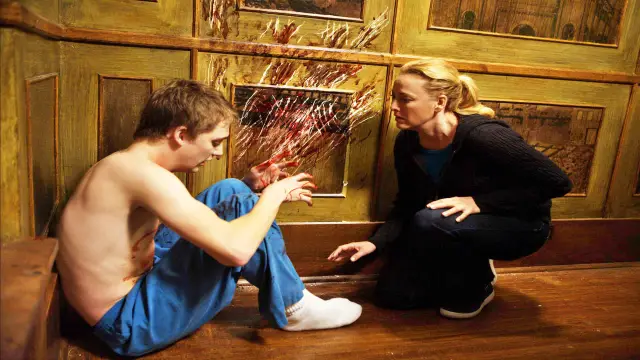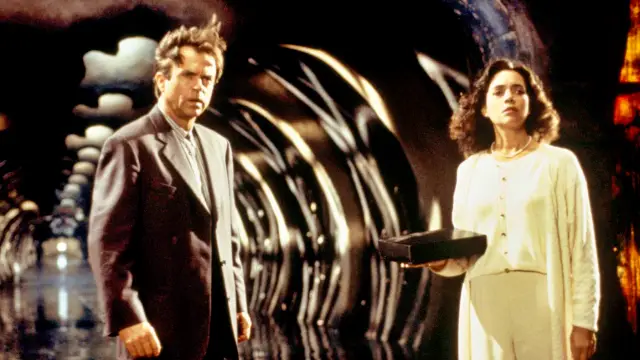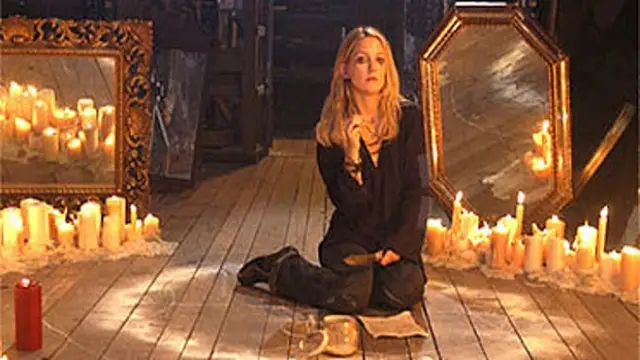From ghost apparitions to demonic possessions, American cinema has a long and chilling history with the supernatural. These five films represent some of the best, most terrifying, and thought-provoking explorations of the unknown. Prepare to be spooked as we delve into stories of haunted houses, restless spirits, and the things that go bump in the night. These aren’t just jump scares; these are films that will stay with you long after the credits roll.
The Haunting in Connecticut (2009)
Director: Peter Cornwell

The Haunting in Connecticut is based on the alleged paranormal experiences of the Snedeker family. In 1986, Allen and Carmen Snedeker moved into a former funeral home in Southington, Connecticut, to be closer to their son’s cancer treatment facility. Soon after, the family claimed to experience disturbing supernatural events, including strange odors, apparitions, and even physical assaults by unseen forces.
The case gained attention when paranormal investigators Ed and Lorraine Warren became involved. Horror writer Ray Garton was hired to write a book about the events, but he later admitted that the Warrens encouraged him to embellish the story. Despite its “based on a true story” tagline, the 2009 film takes significant creative liberties.
Peter Cornwell’s film presents a dramatized version, changing the family’s name to Campbell and adding new horror elements. The film combines traditional haunted house tropes with eerie funeral home imagery and disturbing supernatural manifestations. While not the most groundbreaking horror film, it offers solid performances, particularly from Virginia Madsen and Kyle Gallner, and maintains an eerie atmosphere throughout.
An American Haunting (2005)
Director: Courtney Solomon

This film explores the legend of the Bell Witch, one of America’s most famous ghost stories. The real-life John Bell Sr. and his family reportedly experienced supernatural torment in early 19th-century Tennessee. His daughter Betsy was particularly targeted by violent paranormal attacks. The entity even spoke to the family, identifying itself as Kate Batts, a former neighbor.
Solomon’s film takes inspiration from Brent Monahan’s novel The Bell Witch: An American Haunting. The movie follows a mother in modern times who discovers a journal documenting the Bell Witch case, leading to terrifying revelations. With performances by Donald Sutherland, Sissy Spacek, and Rachel Hurd-Wood, the film attempts to blend historical horror with psychological trauma.
The film suggests that the haunting might be linked to repressed memories of abuse, a unique but controversial twist. Though visually striking, An American Haunting struggles with pacing and doesn’t offer much beyond typical ghost story elements. The modern framing device also feels disconnected from the main narrative.
Session 9 (2001)
Director: Brad Anderson

Unlike typical haunted house films, Session 9 takes place in an abandoned mental asylum, relying on psychological horror rather than traditional jump scares. A team of asbestos removal workers wins a contract to clean out the dilapidated Danvers State Hospital. As they work, tensions rise, and one of the crew members stumbles upon old therapy recordings of a patient with multiple personalities.
As paranoia and fear spread, reality and hallucination blur. The oppressive atmosphere of the asylum itself becomes a character, much like the Overlook Hotel in The Shining.
Brad Anderson crafts a slow-burn horror film that focuses more on psychological breakdowns than supernatural events. With chilling performances and eerie sound design, Session 9 delivers a disturbing descent into madness, making it a unique entry in supernatural horror cinema.
In the Mouth of Madness (1994)
Director: John Carpenter

Inspired by the works of H.P. Lovecraft and Stephen King, In the Mouth of Madness follows insurance investigator John Trent (Sam Neill), who is hired to locate missing horror novelist Sutter Cane (Jürgen Prochnow). Cane’s books have an unusual effect on readers, driving them to insanity and violence. As Trent digs deeper, he realizes Cane’s fictional world is becoming reality.
Carpenter masterfully blends supernatural horror with metafictional elements, questioning the nature of reality itself. The film features unsettling imagery, nightmarish creatures, and a creeping sense of existential dread. In the Mouth of Madness is a cerebral horror film that plays with audience perception, making it a standout in Carpenter’s filmography.
The Skeleton Key (2005)
Director: Iain Softley

Set in the atmospheric Louisiana bayou, The Skeleton Key weaves elements of hoodoo, superstition, and psychological horror into a gripping narrative. Caroline (Kate Hudson) takes a job as a caregiver for a stroke-stricken elderly man, Benjamin (John Hurt). His wife, Violet (Gena Rowlands), is cold and secretive. As Caroline explores the house, she discovers traces of dark rituals and begins to suspect something sinister.
Unlike traditional ghost stories, The Skeleton Key revolves around belief. The film suggests that hoodoo magic only works on those who believe in it, creating an interesting psychological angle. As Caroline uncovers the house’s secrets, she realizes she is caught in a terrifying trap.
With a tense atmosphere, eerie cinematography, and a shocking twist ending, The Skeleton Key remains an underrated gem in supernatural horror.
Conclusion
These five films showcase different approaches to supernatural horror, from haunted houses to psychological torment and Lovecraftian nightmares. Each is defined by its unique setting, whether it’s an eerie funeral home, a cursed homestead, a decaying asylum, a fictional town, or a New Orleans mansion.
If you love horror films that blend ghostly terror with psychological depth, these movies are must-watches. They prove that true horror isn’t just about what lurks in the dark—it’s also about what hides within the human mind.

